Women in healthcare 2017: How does our industry stack up?
We’ve been mining data on gender parity in healthcare leadership since our first report on the topic in early 2012, and the story has remained largely unchanged: Women are a key stakeholder in healthcare, yet are underrepresented in leadership positions across the industry. Unfortunately, this lethargic pace of change has caused women to be pessimistic about the future. In our 2017 survey of over 300 women in healthcare, nearly half (45.4%) of respondents believe it will take 25 or more years until we achieve gender parity in the workplace. Only 7.5% say it will happen in the next five years. And a whopping 16.1% say we will never achieve gender parity.
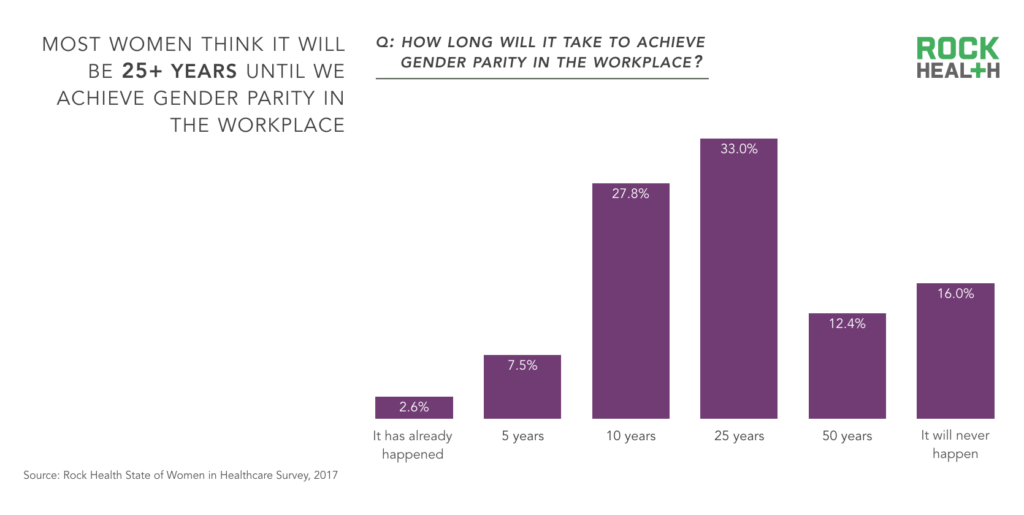
While there’s been a great deal of coverage of the issues women leaders face, current (albeit slow) progress is threatened by emerging burnout around the topic. According to a LinkedIn survey, 40% of male investors and 37% of male founders believe the media spends too much time focused on the state of diversity in tech. That compares to only 15% of female investors and 10% of female founders.
We at Rock Health are especially impatient for momentum—and, quite frankly, frustrated at the necessity of continuing this conversation. But progress depends on it. Our goal with this report is to contribute to a meaningful and actionable dialogue around women in leadership, with the hopes of providing a foundation for our industry to turn this dialogue into action.
The facts
Women are critical stakeholders in healthcare: as workers, caregivers, and consumers. Women’s share of the total labor force is 46.8%, yet on average, they spend more than twice as much time caring for and helping household members. Women also bear a disproportionate burden of informal caregiving for family members, friends, and neighbors, serving as 66% of all caregivers (the estimated value of said informal care is over $148B). On top of all this, women often serve as the “Chief Medical Officer” of the home—making the majority of healthcare decisions and healthcare purchases for the entire family.
Yet women do not have an equal voice in our healthcare system. Not a single woman serves as CEO of a Fortune 500 healthcare company. Only 22.1% of their board members are women, about the same level as the Fortune 500 overall (20.2%). As evidence of the sluggish improvement, in 2015, 21.0% of Fortune 500 healthcare board members were women. At this rate, we won’t reach 50/50 gender parity on healthcare boards until 2049.
The number of women executives (we count VP, President, and Chief titles) at Fortune 500 healthcare companies also increased slightly this year, up from 20.0% in 2015 to 22.6% in 2017. However, not a single healthcare company on the Fortune 500 has fifty-fifty gender balance on its executive team (and two—LifePoint Health and Kindred Healthcare—have a total of zero women in the C-Suite, as of the date this report was published).
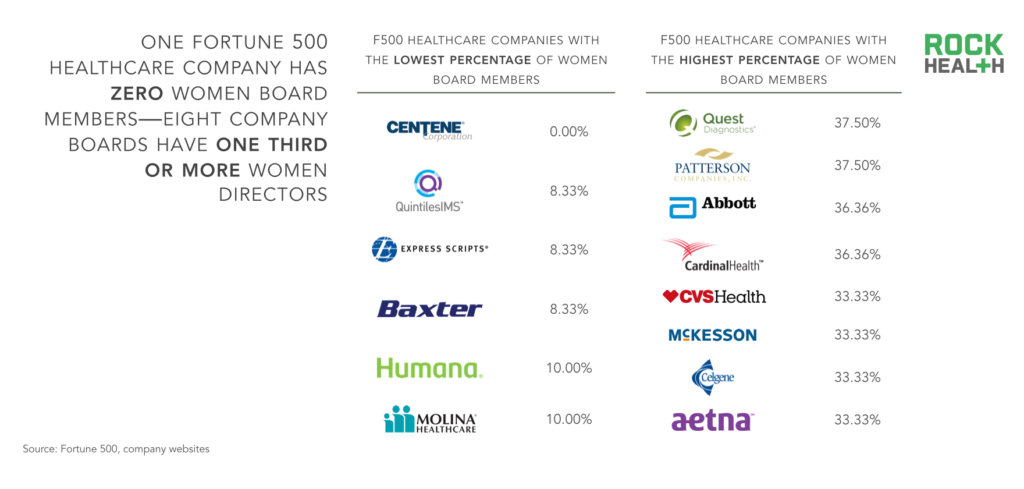
Women who do make it to the executive level are more likely to be in HR (human resources), legal, and marketing functions—and less likely to be in operations or technology. HR is known for being predominantly female—74% of HR managers are women, according to 2016 Bureau of Labor Statistics data. (Which raises the question: what are they doing to help out their female colleagues in other departments?)
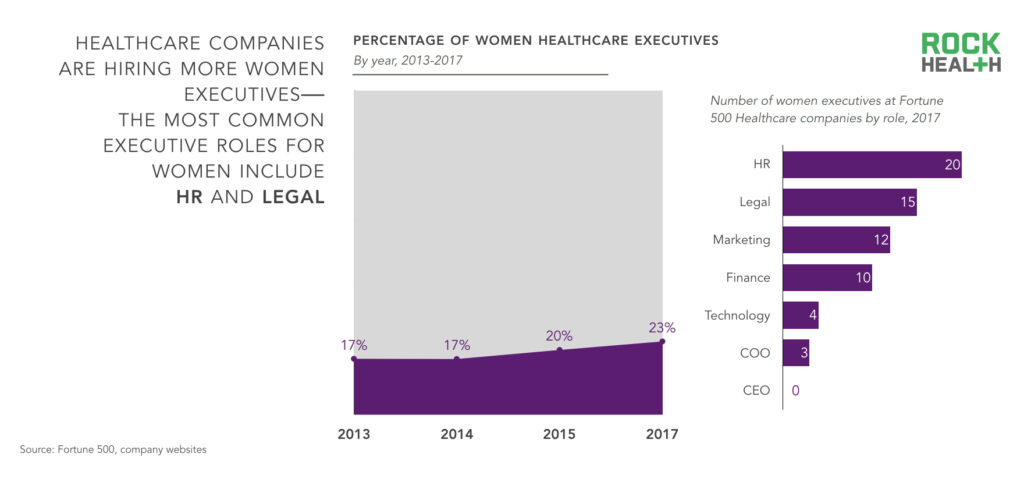
And yet the Fortune 500 looks good compared to the paltry number of women in VC (venture capital). Looking at 131 VC firms who have made five or more investments in digital health, women make up only 10.9% of partners, down from 11.4% in 2015. Hospital investing teams (e.g., Mayo Clinic, UPMC) had slightly more women partners than other types of firms, at 13.0%. Unfortunately, we found that the majority (61%) of VC firms investing in digital health have exactly zero women partners.
The percentage of women investors in digital health is slightly better than in VC overall, where only 8% of partners at top 100 venture firms are women.
VC is a network-driven industry. Partnerships at these firms are multi-year agreements tying partners to portfolio companies, limited partners, and each other. Partnerships are not usually formed through a formal HR-led recruitment and interview process—instead, they generally form between friends and colleagues with existing relationships. Venture firms are tight-knit, closed-door communities with few internal checks and balances apart from the restrictions placed on funds by LPs. A wholesale transformation in the culture of venture capital is needed in order to level the playing field.
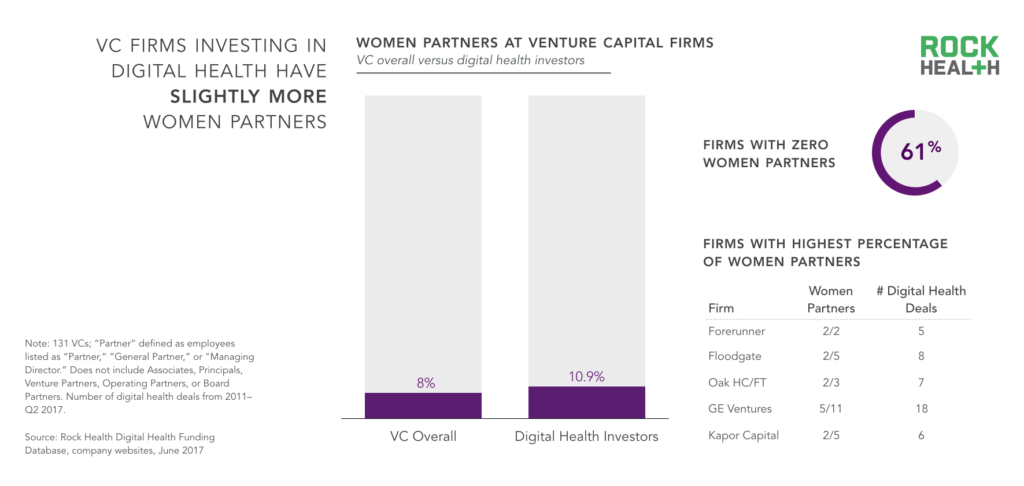
We have had an absolute blast founding Oak HC/FT. There is nothing quite like creating your own firm with people who you respect and share the same core values of fairness, inclusiveness, collaboration and intellectual honesty. We are aligned on one goal, which is we want the firm and the entrepreneurs we back to succeed above all else. We problem solve together and celebrate our successes together and heartily believe the best is yet to come.
Looking at the 100 largest hospitals in the United States (according to Becker’s Hospital Review), we found that women make up nearly one third (32.4%) of executives and 11% of CEOs listed on hospital websites. The percentage of women executives at a hospital increases to 40% when there’s a woman CEO (even though women are often penalized for promoting diversity).
The most common hospital executive role for women leaders is Chief Nursing Officer, where 60% are women. Nursing has long been a field dominated by women, who today make up 83% of professional, active nurses. Despite the overwhelming presence of women nurses, men in the profession still earn higher salaries and are more likely to end up in management positions.
The medical profession is rife with daily indignities and structural bias against women. Because every woman who becomes a doctor has to go through training that’s still rife with sexism, this is a serious problem for the entire profession.
When it comes to doctors, over a third of practicing physicians today are women, compared to just 17% in 1990. And their presence may be associated with better health outcomes: in one study of Medicare beneficiaries, patients treated by female physicians had significantly lower mortality rates and readmission rates than those cared for by male physicians within the same hospital.
But unfortunately, women physicians face higher rates of burnout and depression—all while making $91,000 less a year than their male counterparts. Women physicians have 1.6 times the odds of reporting burnout compared with men, while depression affects 19.5% of women physicians (compared to 12% of male physicians). Furthermore, the suicide rate among female physicians is 2.27 times greater than the general female population (compared to the rate among male physicians, which is 1.41 times higher).
I’ve never worked with as many women leaders as I did at Brigham and Women’s and now at Dana-Farber Cancer Institute. I work alongside a number of women (including our CEO), which makes it an incredibly supportive environment. I’m very satisfied in the academic medical setting, as I know I am contributing to finding cures, saving lives, and providing the highest quality healthcare every day.
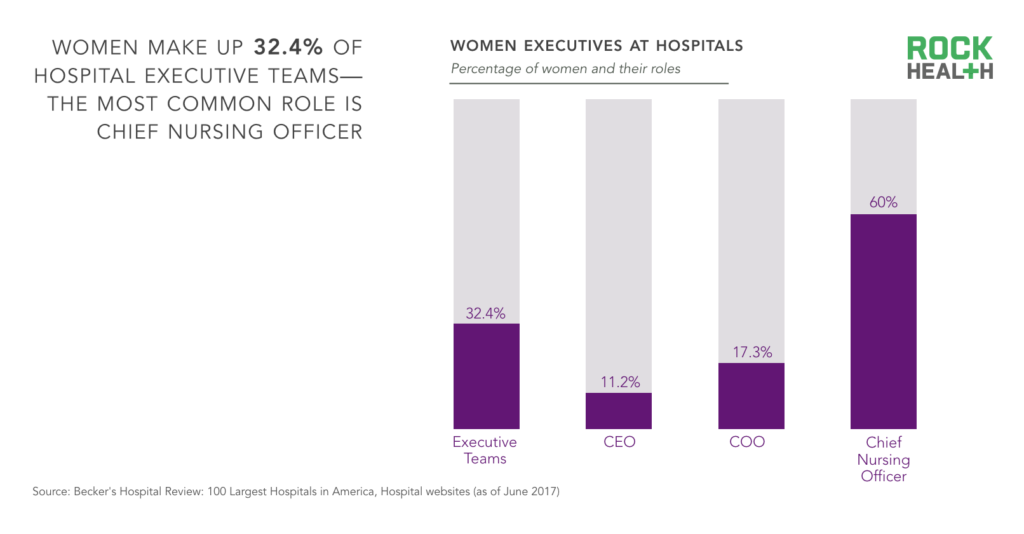
Despite these pitfalls, there is one area where we’ve seen a tremendous increase in gender parity over the last few years: digital health startups. Women make up nearly a quarter (24%) of the CEOs of digital health companies (with $2M+ in funding) founded in 2016—an enormous increase over previous years. Looking at all digital health companies funded since 2011, women comprise 9.7% of CEOs.
There are a few reasons we believe more women are starting digital health companies. First off, more investors are looking to back diverse founders, and are hosting conferences, dinners, and office hours specifically to connect with women founders. There are also more grassroots efforts—like Disruptive Women in Health Care, CSweetener, and our own Rock Health Women—emerging to coalesce and support women in the industry. Finally, some women are starting companies of their own to build the woman-friendly culture missing from their previous corporate roles.
I started CancerIQ not only to fill a need in the cancer market but also to create the kind of company I dreamed of working at. My mom is my co-founder and nearly half our employees are women. But my goal is to make women the majority of our company because that’s how you solve women’s health problems.
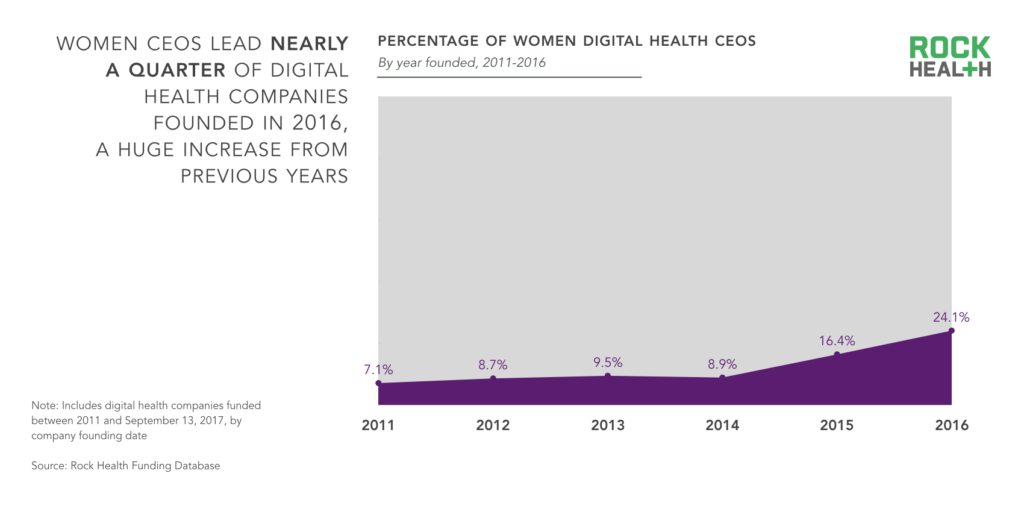
So are women in healthcare better off than in other industries?
Over 13% of the US labor force currently work in healthcare, and jobs in this sector are projected to grow more than twice as fast as the general economy by 2020. But unlike some other industries, healthcare does not have a “pipeline problem.” Women make up 80% of healthcare workers, 84% of bachelor’s degrees in the health professions, 58% of bachelor’s degrees in biological and biomedical sciences, 85% of bachelor’s degrees in nursing, and now represent half of all medical students. Women are well represented in the healthcare workforce—just not at the top.
Forty-two percent of the women we surveyed feel that there are more opportunities for leadership positions for women in healthcare than in other industries (22% feel there are fewer opportunities than other industries, and 36% feel the opportunities are the same). We know that women—as workers, caregivers, and consumers—bring a critical vantage point to the industry. But there is a long way to go until women reach equal numbers in top positions at hospitals, Fortune 500 companies, venture capital firms, and startups.
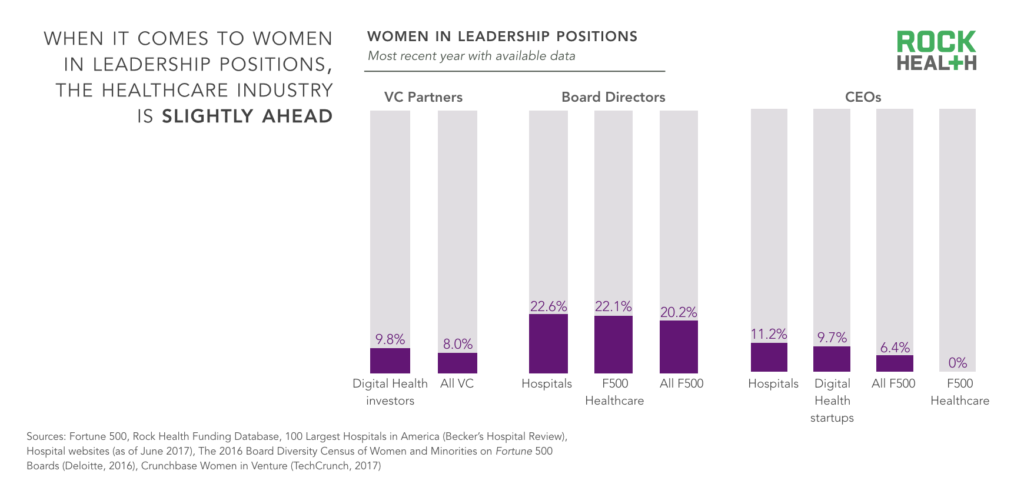
What can we do?
We can all help create work environments that better attract, promote, and support all employees. We should speak out against overt and subtle gender bias, and help push for workplace policies that promote inclusion. Specifically, our survey uncovered three areas where employers can focus:
- Provide better career development opportunitiesWomen in our survey are moderately satisfied with the career development opportunities at their current companies; however, surprisingly, as the employer size gets larger, satisfaction with career development drops. Career development opportunities include leadership trainings, career coaching, formal mentorship/sponsorship programs, and time/funding to attend industry conferences.
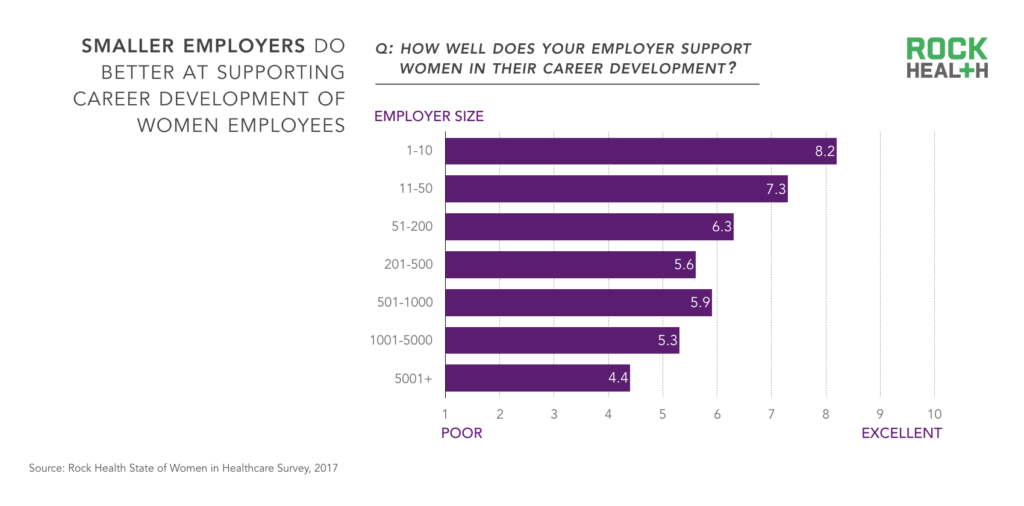
- Push for family-friendly benefitsWhen asked what benefits they would like to see at their organization and in the industry at large, the most common responses among women in our survey were around flexibility (flex hours, remote work) and family-friendly perks (child care, fertility coverage, longer maternity/paternity leave). Specifically, survey respondents suggested “flex time without judgement” and “family leave for parents regardless of gender.”
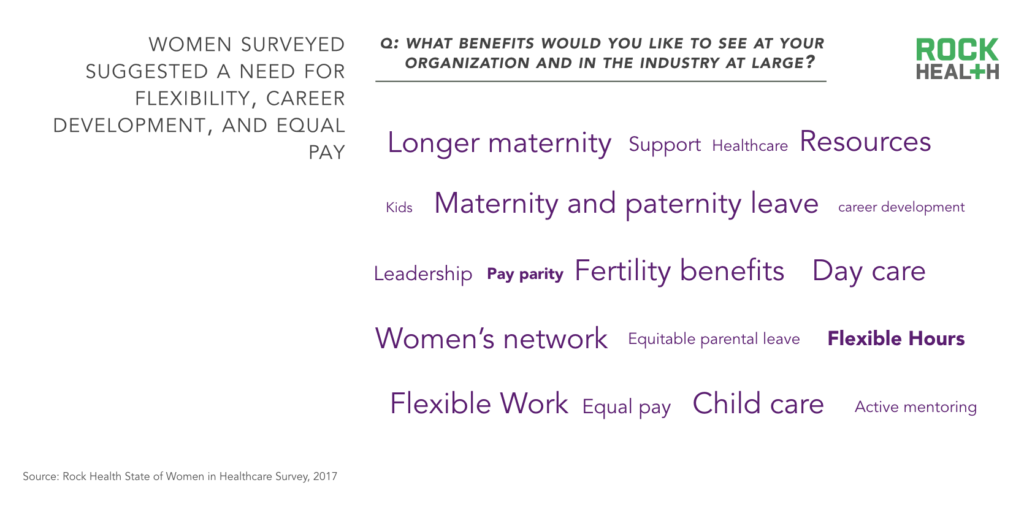
- Make women visibleThe majority of women (58.8%) in our survey felt that their male peers have more role models. As activist Marian Wright Edelman once said, “You can’t be what you can’t see.” This is why it’s imperative that women are in clear line of sight—represented on stage at conferences, interviewed for news articles, and given positions to lead meetings at their organizations. Visible women role models demonstrate to other women that leadership positions are attainable in spite of gender identity.
Finally, if you are an individual seeking ways to spur change from within your company, seek out and talk to leadership about the issues that matter to you and your colleagues. If you are in a position of power, create and be present for ideas and feedback—there’s a lot to learn outside of the echo chambers of leadership meetings, from the actual people affected by your company’s culture and policies.
As long as gender inequity persists in the industry, we’ll be here to report on it. But gender parity is just the first step. As advocate Vernã Myers puts it, “Diversity is being invited to the party; inclusion is being asked to dance.” We’ll continue to report on gender diversity in the healthcare industry, but we hope to expand our dialogue to also include promoting a sense of belonging for women. Join us on Wednesday, 11/1 at 11am PT as we kickoff this conversation with a Twitter Chat featuring our portfolio companies to learn more about how they are actively supporting women.
